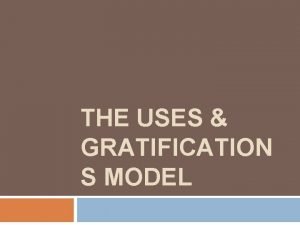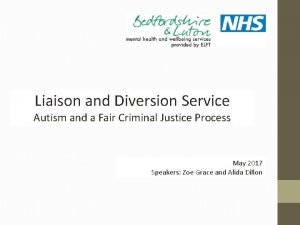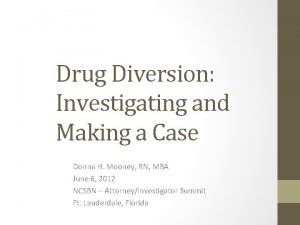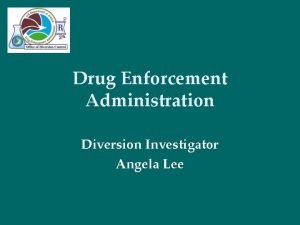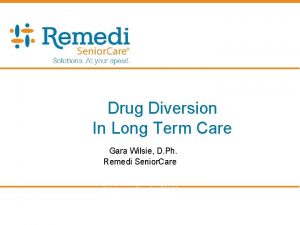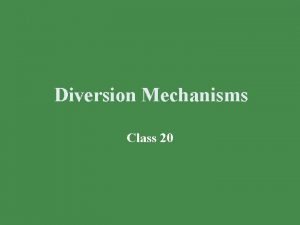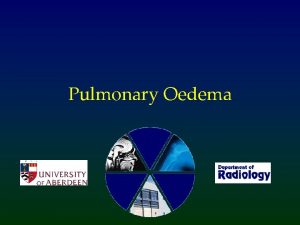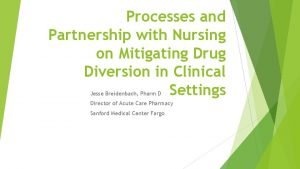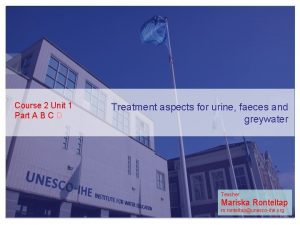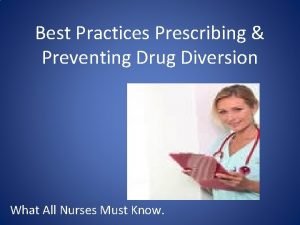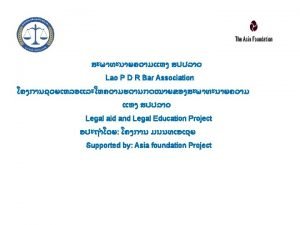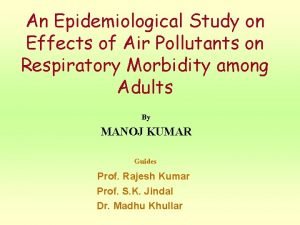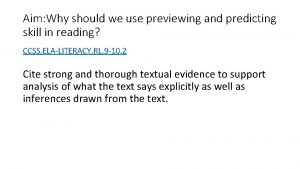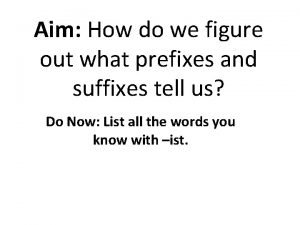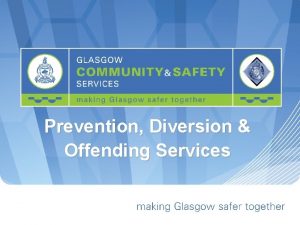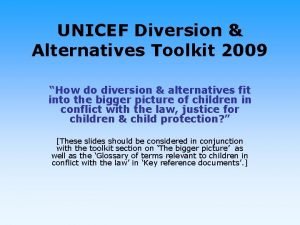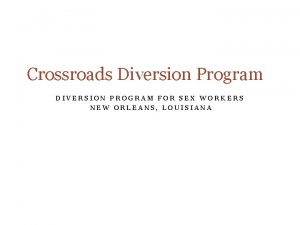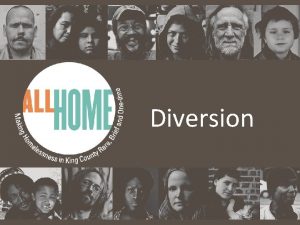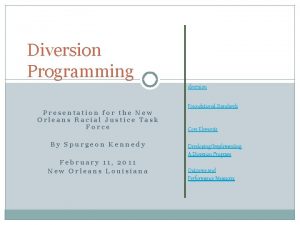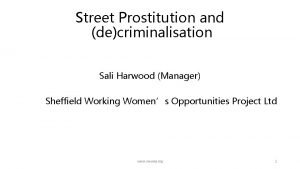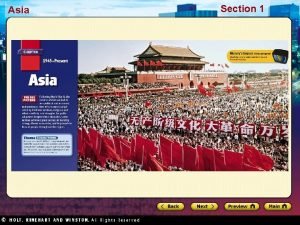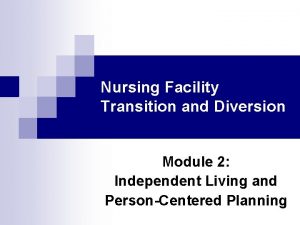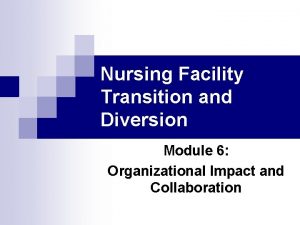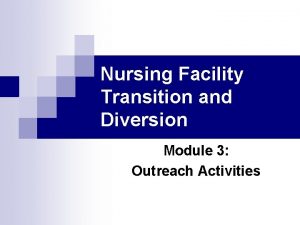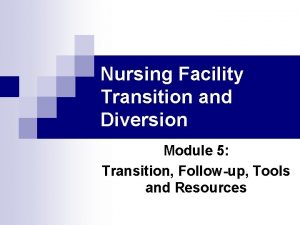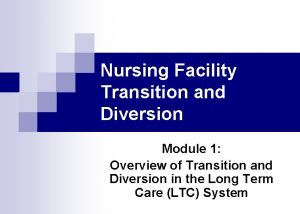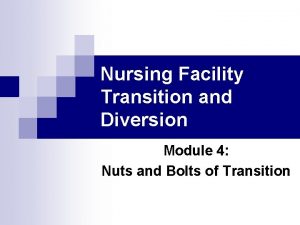MODULE 8 Decriminalisation and diversion in Asia Aim


























- Slides: 26

MODULE 8 Decriminalisation and diversion in Asia

Aim and learning objectives Aim: To identify the gold standard of decriminalisation and develop effective advocacy interventions to promote both decriminalisation and diversion programmes. Learning objectives: Participants will gain an understanding of: • The key components of an effective decriminalisation model • The diverse ways of diverting people away from prison and towards effective and humane health and social services • How to effectively advocate for decriminalisation and diversion.

Module 8 SESSION 8. 1 The rationale for promoting decriminalisation

Session 8. 1: Cause and effects exercise Further effect Effect Punishment/ criminalisation of PWUD Cause of this cause? Cause of this cause? Further effect

Session 8. 1: The rationale for decriminalisation in Asia Harsh punishment has no deterrent effect High level of stigma and discrimination HIV epidemic driven by injecting drug use Abuses perpetrated by law enforcement officers against PWUD • Prison overcrowding • Adverse human security outcomes • •

Session 8. 2: What is decriminalisation? Definition: Removal of criminal penalties for the following activities: • Drug use • Possession of drugs for personal use • Cultivation and purchase for personal use • Possession of drug use paraphernalia Objective: Ending the punishment and stigmatisation of PWUD & promote access to health and social services

Session 8. 2: What is decriminalisation? De jure decriminalisation: removal of criminal sanctions takes place through a legislative process (repeal of criminal legislation, creation of civil law, constitutional court decision leading to legislative review). E. g. : Portugal. De facto decriminalisation: drug use remains a criminal offence in law, but in practice people are no longer prosecuted. E. g. : The Netherlands. Decriminalisation ≠ Legalisation

Session 8. 3: The gold standard of decriminalisation Session to be conducted in 3 steps: STEP 1: Differentiating between possession for personal use and possession with intent to supply STEP 2: Identifying who is responsible for determining whether is for personal use STEP 3: Identifying the adequate response to drug use.

Session 8. 3: The gold standard of decriminalisation STEP 1: Differentiating between personal use and intent to supply What tools could be used to differentiate between personal consumption and commercial purposes?

Session 8. 3: The gold standard of decriminalisation STEP 1: Differentiating between personal use and intent to supply • Some have used quantity thresholds: – Positive aspects: can clearly distinguish between use and dealing – Negative aspects: • no international standard to establish thresholds, lack scientific basis

Session 8. 3: The gold standard of decriminalisation Quantity thresholds for cannabis across the world

Session 8. 3: The gold standard of decriminalisation STEP 1: Differentiating between personal use and intent to supply • Some have used quantity thresholds: – Positive aspects: can clearly distinguish between use and dealing – Negative aspects: • no international standard to establish thresholds, lack scientific basis • Quantity thresholds set too low leading to more people sent to prison (e. g. Lao PDR, Thailand, Vietnam) • Issue of people buying larger quantities for personal use • Others do not define ‘reasonable’/‘small’ amounts and use available evidence on a case-by case basis (money, firearms, drug dependency…). But risk of abuse and corruption

Session 8. 3: The gold standard of decriminalisation STEP 1: Differentiating between personal use and intent to supply The gold standard: • Indicative quantity thresholds • Combined with discretionary powers for police/prosecutor/judge to decide on a case-by-case basis using all available evidence at hand.

Session 8. 3: The gold standard of decriminalisation STEP 2: Who is responsible to determine personal use/intent to supply? • Identify the entities that may be able to determine whether possession is for personal use or intent to supply • What are the positive and negative aspects associated with each entity’s power to decide?

Session 8. 3: The gold standard of decriminalisation STEP 2: Who is responsible to determine personal use/intent to supply? POLICE PROS CONS PROSECUTOR COURT HEALTH/SOCIA L WORKERS

Session 8. 3: The gold standard of decriminalisation STEP 2: Who is responsible to determine personal use/intent to supply? • Leave the role of determination to the police to avoid lengthy pretrial detention • But there also risks: harassment, racial discrimination, excessive fines, net-widening • Always need to keep in mind that the objective is to reduce the number of people punished for drug use • Need to adopt solid prosecutorial guidance, tight scrutiny of police behaviour, guidance on how to assess quantity thresholds, how to exercise police discretion, train police on harm reduction and drug use. Need to engage PWUD • Important role played by health, legal and community workers

Session 8. 3: The gold standard of decriminalisation STEP 3: Identifying the adequate response Draft a diagram showing the various steps of an effective decriminalisation model from the moment is stopped in possession of drugs and what comes next (penalties? referrals? entity responsible and for what? )

Session 8. 3: The gold standard of decriminalisation STEP 3: Identifying the adequate response • Significant difference around the world on the response given to drug use within a decriminalisation model • Critical to remove all punitive sanctions for drug use (e. g. CCDUs, compulsory registration, urine testing, etc. ) • Ensure that referral mechanisms are in place to access harm reduction and treatment services, but these should be voluntary and focused on addressing the health and social needs of PWUD. • Treatment failure should not lead to the imposition of criminal sanctions • Avoid excessively high fines or seizure of passport or driver’s licence

Session 8. 4: Advocating for decriminalisation Role-play exercise Scenario: Your NGO is invited at a national drug policy conference organised by the government. You know that the event will involve high-level influential policy makers and police officers, as well as religious leaders and other NGO colleagues. The media will also be present to report on the outcomes of the event. The conference’s agenda is mainly focused on drug law enforcement and criminal justice issues, it will therefore be the perfect opportunity for you to highlight the need for decriminalisation of drug use. On the day of the conference, you are among 200 attendees. At the coffee break, you manage to get the attention of your target and have 3 minutes to convince them about the need to decriminalise drug use in the country.

Session 8. 5: Promoting diversion mechanisms • Mechanisms to divert PWUD away from the criminal justice system and, where appropriate, towards treatment, harm reduction, counselling, etc. • Focus: drug use, possession of drug use equipment, non-violent offences related to use, low-level dealing • Authorities responsible: police, prosecutors or courts, as well as community-based health and social workers • Important health benefits and can enhance human security • Can be implemented in contexts where drug use is decriminalised, or continues to be criminalised

Session 8. 5: Promoting diversion mechanisms Case studies exercise • What is the rationale behind this diversion model? • What do you think are the positive/negative impacts of such a model for people who use drugs and low-level drug offenders? • How could the model be improved?

Session 8. 5: Promoting diversion mechanisms: Diversion by the police • Effective if police can build trust with communities of PWUD and when corruption levels are low • Diversion should include a decision to take no further action, issue a caution and/or refer to health & harm reduction services • When people are found in possession of small amounts of drugs or paraphernalia, diversion should occur before a charge is entered • Diversion should involve an educational component on harm reduction or information on existing health, treatment, harm reduction or community support services • Arrest quotas for drug use should be abolished

Session 8. 5: Promoting diversion mechanisms: Diversion by the prosecutor • Include the option not to prosecute PWUD in prosecutorial guidelines • Prosecutor should have the option to take no further action, or take no further action conditional upon an offender attending a harm reduction service, a treatment programme if required or other social services • Decisions should be based on a solid understanding of the distinction between occasional use and drug dependence

Session 8. 5: Promoting diversion mechanisms: Diversion by the court • Include the option to impose no penalty and not to enter a conviction for PWUD • If court diversion programmes operate, they should supplement police and prosecutors’ diversion schemes and also focus on more serious drug-related offences committed by PWUD (not only drug use) • Sentencing guidelines should support use of non-custodial sentences including treatment in the community • Decisions should be based on multi-disciplinary advice and offer: – Pre- and post-sentencing referrals to voluntary, community-based treatment, harm reduction and social services – Individualised treatment, harm reduction and social support options

Session 8. 5: Promoting diversion mechanisms: Legal aid and access to justice PWUD should have access to independent legal advice and representation to ensure they are informed of their rights and are able to defend their case at all stages of the process

Session 8. 5: Promoting diversion mechanisms: The role of healthcare workers • Intervene at community level to refer PWUD before any police contact • Provide health assessments to inform the decisions of police, prosecutors and courts in relation to diversion • Provide a holistic assessment and response to the needs of PWUD diverted away from the criminal justice system • Engage in partnerships with communities, police and justice sector to promote harm reduction and health approaches • Adopt minimum quality standards to ensure that treatment programmes are based on evidence and human rights • Monitor and evaluate the quality & effectiveness of diversion models
 Trade diversion and trade creation
Trade diversion and trade creation Diversion uses and gratification
Diversion uses and gratification Trade diversion and trade creation
Trade diversion and trade creation Trade diversion and trade creation
Trade diversion and trade creation Trade diversion and trade creation
Trade diversion and trade creation Liaison and diversion interview questions
Liaison and diversion interview questions Investigating and making a case for drug diversion
Investigating and making a case for drug diversion Marc exports
Marc exports Diversion program ra 9344
Diversion program ra 9344 Diversion head work
Diversion head work Dea diversion investigator
Dea diversion investigator Drug diversion investigation checklist
Drug diversion investigation checklist Diversionary principles
Diversionary principles Upper lobe blood diversion
Upper lobe blood diversion Drug diversion investigation checklist
Drug diversion investigation checklist Judge robert tejeda
Judge robert tejeda Urine diversion
Urine diversion Eviction diversion program richmond va
Eviction diversion program richmond va Drug diversion best practices
Drug diversion best practices C device module module 1
C device module module 1 Legal aid meaning aim and objective
Legal aid meaning aim and objective Unit 5 health and social care coursework example p3
Unit 5 health and social care coursework example p3 Unit 14 physiological disorders assignment 2
Unit 14 physiological disorders assignment 2 Aims of air pollution
Aims of air pollution The major objective of the creation of pakistan was
The major objective of the creation of pakistan was What is previewing
What is previewing Antibene
Antibene

